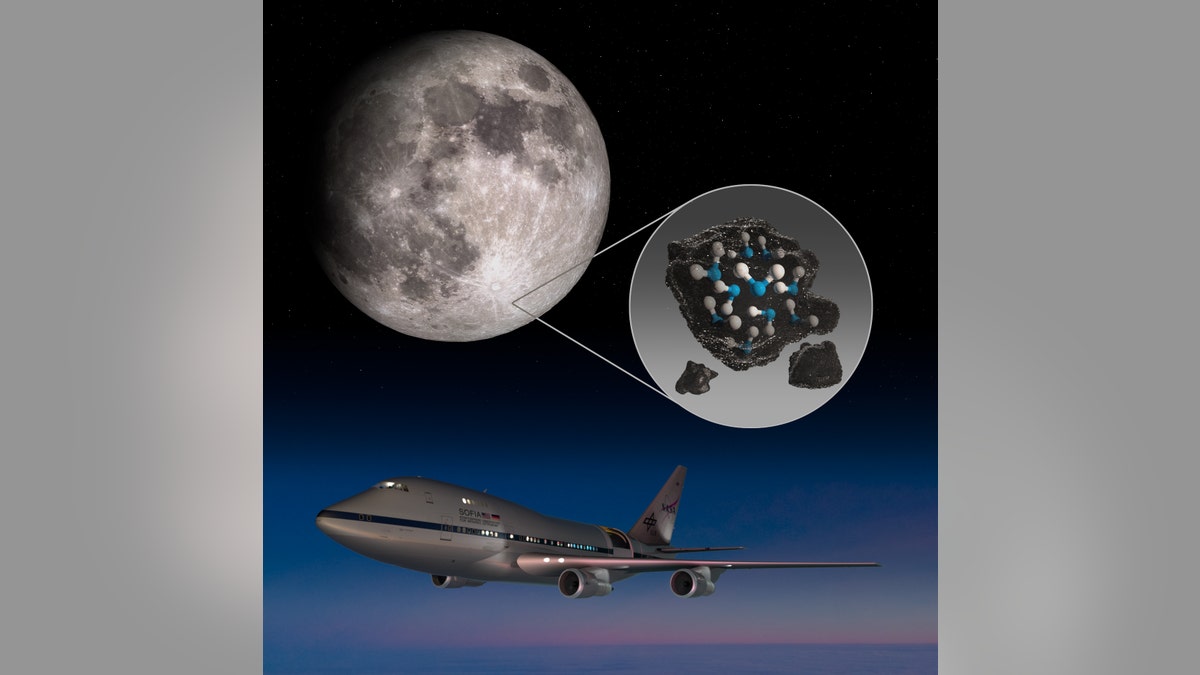NASA announced it has discovered water on the sunlit surface of the moon.
The water was spotted near the Clavius crater, one of the largest crater formations on the celestial satellite and one that can be seen with the naked eye, Paul Hayne, a planetary scientist at the University of Colorado, said on a conference call with the press. Hayne is the lead author of one of the studies published on the topic.
Casey Honniball, lead author of the other study, said there are between 100 and 400 parts per million of water, or "roughly the equivalent of a 12-ounce bottle of water within a cubic meter of lunar soil."
NASA HAS A PLAN FOR YEARLY ARTEMIS MOON FLIGHTS THROUGH 2030. THE FIRST ONE COULD FLY IN 2021.

This illustration highlights the Moon’s Clavius Crater with an illustration depicting water trapped in the lunar soil there, along with an image of NASA’s Stratospheric Observatory for Infrared Astronomy (SOFIA) that found sunlit lunar water. (Credit: NASA)
“We had indications that H2O – the familiar water we know – might be present on the sunlit side of the Moon,” said Paul Hertz, NASA's director of the Astrophysics Division in the Science Mission Directorate, in a statement. “Now we know it is there. This discovery challenges our understanding of the lunar surface and raises intriguing questions about resources relevant for deep space exploration.”
The study led by Honniball found the presence of water directly on the surface, while Hayne's study speculated that water may be trapped in "small spatial scales" all over the surface of the moon.
Researchers have known for some time about the existence of that water on the moon, having first discovered water vapor as early as 1971. In 2009, the first evidence of frozen water on the surface was discovered.
On the call, Jacob Bleacher, chief exploration scientist for NASA’s Human Exploration and Operations Mission Directorate, said the results are "exciting for human exploration," but there are greater implications for it. "Understanding where the water is will help us determine where to send Artemis astronauts on the moon," Bleacher explained.
NASA WILL SHOOT LASERS AT THE MOON TO HELP FIND WATER
The new studies note it could be significantly more accessible than previously thought. As such, the water could be used for drinking, fuel supply and other use cases.
Water was previously believed to only exist on areas of the moon that are always in shadows and do not receive sunlight, making them dangerous and frigid for astronauts to access.
“Prior to the SOFIA observations, we knew there was some kind of hydration,” Honniball added in the statement. “But we didn’t know how much, if any, was actually water molecules – like we drink every day – or something more like drain cleaner.”
The discovery was made from NASA's Stratospheric Observatory for Infrared Astronomy (SOFIA), described as "the world’s largest airborne observatory."
SOFIA is a modified Boeing 747 airplane capable of flying high in Earth's atmosphere, allowing for its 9-foot telescope to get a "clear view of the universe and objects in our solar system." It is able to observe infrared wavelengths that are capable of detecting "phenomena impossible to see with visible light," NASA added.
TRUMP WANTS TO SEE NASA BOOTS ON THE MOON
In 2018, a separate group of researchers published a study that suggested water on the moon may be more accessible than first thought.
The findings come in advance of NASA's Artemis program, which is intended to land American astronauts on the moon by 2024, as well as establish a sustainable human presence on Earth’s natural satellite.


